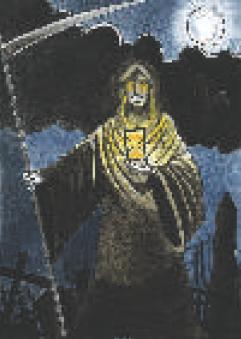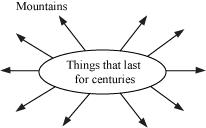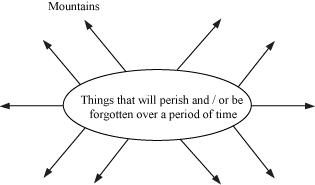Unit-9 : Solutions of Questions on Page Number : 102
Q1 : Look at the following picture carefully.

What has Time been portrayed as? Why?
Answer :
Note: This question is to be answered on the basis of your own understanding, experience and thoughts. It is strongly recommended that you prepare the solution on your own. However, sample solutions have been provided for your reference.
Time has been portrayed as a man carrying the banner in his hands. The image looks much similar to that of Lord Christ. It has been portrayed so because there is nothing more powerful than man, although man’s identity and importance is very small in relation to time. Secondly, time has been portrayed as a human being because the poem is meant for them.
NCERT Solutions for Class 10 English Literature Reader Chapter 9
Q2 : What are the other symbols associated with Time?
Answer :
Note: This question is to be answered on the basis of your own understanding, experience and thoughts. It is strongly recommended that you prepare the solution on your own. However, sample solutions have been provided for your reference.
Other symbols related to that of time might belong to nature, like the sun.
Q3 : What are the things that last for centuries? List a few things around you that will survive four to five hundred years into the future.

Answer :
Note: This question is to be answered on the basis of your own understanding, experience and thoughts. It is strongly recommended that you prepare the solution on your own.
Q4 : Think of things that will perish and/or be forgotten with the passage of time.

Answer :
Note: This question is to be answered on the basis of your own understanding, experience and thoughts. It is strongly recommended that you prepare the solution on your own.
Q5 : The rich and powerful got ornate monuments made in order to _______________
i. show off their wealth
ii. display their power
iii. show their artistic talent
iv. be remembered till posterity
Answer :
iv. be remembered till posterity
Q6 : The poet addresses his sonnet to _________________
i. time
ii. war
iii. the person he loves
iv. powerful rulers
Answer :
iii. the person he loves
Q7 : In the line ‘The living record of your memory’, living record refers to ____________
i. the sonnet the poet has written for his friend
ii. an existing statue of his friend
iii. his friend who lives in the poet’s memory
iv. the autobiography of the poet’s friend
Answer :
i. the sonnet the poet has written for his friend
Q8 : The poet’s tone in the poem is _________________
i. despairing
ii. optimistic
iii. loving
iv. admiring
Answer :
iii. loving
Q9 : The poem is set in _______________________
i. the place where the poet meets his friend
ii. a battlefield where Mars is fighting a battle
iii. a city ravaged by war
iv. the poet’s study where he is writing
Answer :
iv. the poet’s study where he is writing.
Q10 : Why do you think the rich and powerful people get monuments and statues erected in their memory?
Answer :
In order to be remembered till posterity, the rich and powerful people get monuments and statues erected in their memory.
Q11 : Describe how the monuments and statues brave the ravages of time.
Answer :
The monuments and statues brave the ravages of time. However, in the process, they get ruined, disfigured, broken or spoiled, if not taken proper care of.
Q12 : Why does the poet refer to Time as being sluttish?
Answer :
The poet refers to Time as sluttish because it spoils the marbled or gilded monuments. It discolors them, spoils them and ruins them gradually through its various agents or forces. These agents are like air, rain, natural vegetation, etc.
Q13 : The poet says that neither forces of nature nor wars can destroy his poetry. In fact, even godly powers of Mars will not have a devastating effect on his rhyme. What quality of the poet is revealed through these lines?
Answer :
The permanence of his poetic art and the immortality of his verse is a characteristic trait which can be noticed in the quality of the poet. It is a well known fact that like Time and Nature, literary art is also immortal and permanent, making poets live through their work, for thousands of years.
Q14 : Shakespeare’s sonnet has been divided into three quatrains of 4 lines each followed by a rhyming couplet. Each quatrain is a unit of meaning. Read the poem carefully and complete the following table on the structure of the poem
|
Rhyme Scheme |
Theme |
|
| Quatrain 1 | Comparison between poetry and monuments. | |
| Quatrain 2 | Ravages of time on monuments contrasted with ___________________. |
|
| Quatrain 3 | The recorded memory of ____________ posterity. | |
| Quatrain 4 | Poetry immortalizes friend. |
Answer :
|
Rhyme Scheme |
Theme |
|
|
Quatrain 1 |
ABAB |
Comparison between poetry and monuments. |
|
Quatrain 2 |
CDCD |
Ravages of time on monuments contrasted with living |
|
Quatrain 3 |
EFEF |
The recorded memory of his beloved shall find room |
|
Quatrain 4 |
GG |
Poetry immortalizes friend. |
Q15 : (a) The poet uses alliteration to heighten the musical quality of the sonnet.
Working in pairs, underline the examples of alliteration in the poem.
Answer :
- A few instances of alliteration in the poem are:
- Unswept stone besmear’d with sluttish time;
- When wasteful war;
- Nor Mars his sword nor war’s;
- Praise shall still;
- Lover’s eyes.
Q16 : Identify Shakespeare’s use of personification in the poem.
Answer :
“The living record of your memory” has been personified here in the sonnet as a man. He shall pace forth against death, bereavement, etc. He shall live life even in the eyes of all posterity.